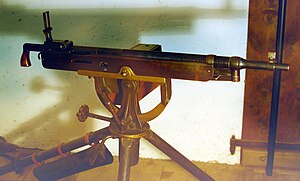M1895 Colt-Browning machine gun
| M1895 Colt–Browning machine gun | |
|---|---|

Colt–Browning M1895/14 machine gun in 7mm Mauser caliber, possibly used in the Mexican Revolution.
|
|
| Type | Machine gun |
| Place of origin | United States |
| Service history | |
| Used by | See Users |
| Production history | |
| Designer | John M. Browning, Matthew S. Browning |
| Designed | 1889–1895 |
| Manufacturer |
Colt Marlin Rockwell |
| Specifications | |
| Weight | 16 kg (35.3 lb) |
| Length | 1040 mm (41 in) |
| Barrel length | 711 mm (28 in) |
|
|
|
| Cartridge |
6mm Lee Navy 7×57mm Mauser .30-40 Krag .30-06 Springfield .303 British 7.62×54mmR 6.5×52mm Mannlicher–Carcano |
| Action |
Gas-operated, lever actuated closed bolt firing cycle |
| Rate of fire | 400–450 rpm |
| Feed system | Belt |
| Sights | Iron sights |
The Colt–Browning M1895, nicknamed "potato digger" because of its unusual operating mechanism, is an air-cooled, belt-fed, gas-operated machine gun that fires from a closed bolt with a cyclic rate of 450 rounds per minute. Based on a John Browning and Matthew S. Browning design dating to 1889, it was the first successful gas-operated machine gun to enter service.
Filed for patent in 1892, the M1895's operating mechanism was one of Browning's and Matthew S. Browning's early patents for automatic rifles; they had previously been working on lever action rifles for Winchester such as the Winchester 1886.
In a typical lever action design, the operating lever lies under the rear of the gun, typically below the stock, and is hinged near the breech area. It is operated by rotating the lever down and forward, which causes the breechblock to slide rearward away from the barrel and eject the spent round. The potato digger mechanism bears some similarities to the basic lever action design, in effect it uses a lever that is powered by the expanding gasses that are propelling the bullet down the barrel, rather than the operator's hands.
The M1895 used a tilting bolt to lock into position when firing, the first example of such in a machine gun design. The bolt slid forward and rearward within a slot in the receiver area, held forward by a spring inside the tube that also held the operator's grip handle. As it moved forward the bolt eventually met the barrel. At that point a cam below the bolt dropped into a hole which allowed the rear of the bolt to tilt downward, seating it against the rear of the breech and locking it in position. The bolt remained locked when the round was fired.
As the bullet travelled down the barrel after firing, it eventually passed a hole drilled in the bottom of the barrel known as a port. The hot gasses behind the bullet flow into the port and push down on a plug, marked p in the diagrams. This causes the plug to pop out of the hole with some velocity. The plug is attached to one end of a short lever, l, the other end of the lever is connected to a hinge below the barrel. The motion of the plug causes the entire lever to rotate down and to the rear, around the hinge point. This action is essentially front-to-back version of the typical back-to-front motion of a lever action rifle. The end point of this motion can be seen in the lower diagram, with the lever having traveled through an arc of about 160 degrees. A spring located at the hinge is compressed by this motion, and eventually causes the lever to rotate forward again, forcing the plug back into the port and holding it there when it is not in motion.
...
Wikipedia
